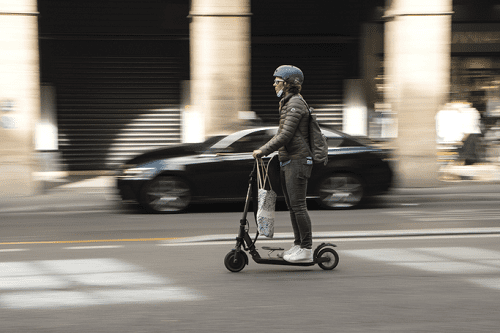Top tips reduce the risk of e-bike and e-scooter fires

Authored by Allianz
As more and more people choose to use e-bikes and e-scooters for commuting and personal use, emergency services and insurers are seeing a worrying increase in fires.
The London Fire Brigade has described e-bike and e-scooter battery blazes as ‘the capital’s fastest-growing fire trend’. Its data shows a 53% increase in these fires in 2023 compared to 2022 with 150 e-bike fires and 28 e-scooter fires. Tragically, fatalities and injuries are now a real concern, with fires from lithium-ion batteries used to power these devices, accounting for at least 8 fatalities and 190 injuries since 2020, in the UK alone. This isn’t just a UK problem, with 1,370 injuries and 251 fatalities attributed to micro-mobility devices (<20mph) worldwide 2.
Why do lithium-ion batteries catch fire?
Most e-bikes and scooters are powered by lithium-ion batteries, which are easily recharged. They have the capacity to retain large amounts of energy in a relatively small battery. However, if lithium-ion batteries overheat or are damaged or incorrectly charged/discharged, they can catch fire quickly and dramatically. This can lead to a thermal runaway, or flammable gases can build up, which are invisible to the eye, leading to the potential for a large explosion and spreading the resulting fire. Toxic gases including carbon monoxide and hydrogen fluoride are also produced, compounding the risk.
Who should know?
Anyone who owns, manages a building or is responsible for personnel, should ensure that there is a clear policy around e-bikes and e-scooters. This policy should be communicated to everyone including employees, tenants, occupiers, visitors and contractors. Everyone using the building has a role to play in preventing fires from starting.
What are the warning signs?
Excessive amount of heat when a battery is being used or damaged.Physical signs of bulging, swelling, change in shape or leaking.Hissing noise could indicate that gas is being produced and released.Once smoke is seen a fire has already started.
Top tips to reduce the risk of e-bike and e-scooter fires
As with any new changes to the building activities or uses, revisit your Fire Risk Assessment and communicate the results with the relevant individuals.Where possible charge / store in a separate building or covered external area, at least 10 m from main building or essential plant.Avoid areas of the building that may be difficult to reach by the Fire & Rescue Services, for example basements.Detail the location of any dedicated charging area in plans should be provided to the Fire & Rescue Services, in the event of a fire and / or explosion.Advise users of any products containing lithium-ion batteries to always use the original equipment manufacturer (OEM) approved charger.Charging should be prohibited in or near an escape route.Always charge in an area covered by smoke detection, where charging in the building can’t be avoided.Advise users to buy e-bike, e-scooter, chargers and batteries from a reputable retailer. Items which don’t comply with British or European standards pose a huge risk.Where e-bikes or e-scooters are stored in the building, all users should check the battery regularly for any signs of damage, but especially if suspected that there has been any physical damage, for example dropping it or involved in an accident. If the battery is damaged it can catch fire without warning, so do not charge or use it and remove from the building immediately.Any occupiers of the building, can check any products that have been bought, are not subject to a product recall at Product Recalls & Safety Notices | Electrical Safety First or Product Recalls and Alerts – GOV.UK.





